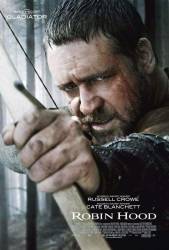Factual error: On the cliff top before the battle on the beach, you are treated to a lovely if fleeting glimpse of wind farm turbines, not really fitting for the 12th Century.

Robin Hood (2010)
Directed by: Ridley Scott
Starring: Cate Blanchett, Russell Crowe, Max von Sydow, Mark Strong, Matthew Macfadyen
Factual error: In the beginning of the film, the opening text states that it is the turn of the 12th century. However, the first scene of the movie says that the year is 1199 A.D., which is the turn of the 13th century.
Factual error: Richard I was not fighting his way back across Europe following the Crusades when he was killed. He had already returned to England and put down John's rebellion before returning to France to put down rebellions there.
Trivia: After Robin and his men arrive in Nottingham, Will Scarlet and Little John are in a tavern admiring the women - Will advises his comrades not to go for the most beautiful woman, but to go for her less attractive friends, thus ensuring success. This is the expression of Game Theory, as explained by John Nash (also played by Russell Crowe) in A Beautiful Mind.
Trivia: William Hurt as William Marshal repeats a line that he first spoke in "The Big Chill" with exactly the same inflection. In "The Big Chill" he was referring to his departed friend Alex, and in "Robin Hood" he was referring to King Richard. The line is: "Look what happened to him."
Robin Longstride: Rise, and rise again. Until lambs become lions.
Robin Longstride: If you thought it was hard getting wages from him when he was alive, try getting wages from a dead king.
Godfrey: In the name of King John, pay or burn.
Question: An interesting wind-up lute-type musical instrument is played at one point. Would such an instrument have existed at that time?
Question: When the caravan that is moving the grain is captured by Robin Hood, he ties the men together and they are forced to walk back to the town ("17 miles" or so). Shouldn't they have used the metric system to state the distance they have to travel to the town? I thought stating the distance to be traveled in miles was just for the sake of the joke for American viewers.
Chosen answer: A "mile" is not American in origin. The British adapted it from the ancient Roman term, "mille passuum," meaning one thousand paces or strides. Each pace was the length of five Roman feet, resulting in a mile that was approximately 5,000 feet long. This measurement fluctuated up until the Tudor era, when Parliament established the current measuring standard, though the metric system, which was developed by the French in the late 1700s, has since replaced it in Europe and elsewhere. Britain still uses mile as a standard measure of distance on road signs and for speed limits, etc.
Join the mailing list
Separate from membership, this is to get updates about mistakes in recent releases. Addresses are not passed on to any third party, and are used solely for direct communication from this site. You can unsubscribe at any time.
Check out the mistake & trivia books, on Kindle and in paperback.




Answer: By "Wind-up lute", I assume you mean the hurdy-gurdy. Certainly, instruments fitting the description of the hurdy-gurdy were around in the time when Robin Hood was set.
Madstunts